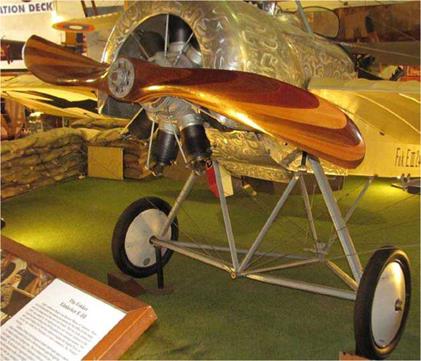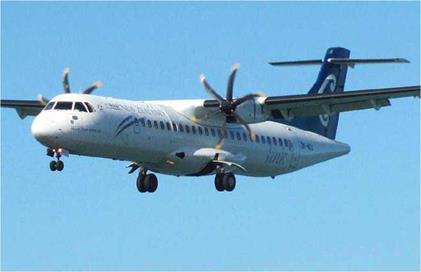Tips, Blade Shape & Materials
Wooden propellers due to their inherent thickness required for structural strength, are more suitable for low speed aircraft with lower tip speeds operating up to 660 FPS (200 m/sec) maximum. At higher speeds, the thicker sections create more drag and compressibility may become a factor. Metal props have thinner blade sections and they can operate to higher tip speeds: 880 FPS (268 m/sec) is an average
|
A Fokker E-MI Eindecker of WW I era with a carved, laminated and scimitar shaped propeller. This aircraft is located in the Air & Space Museum, San Diego, Calif. |
maximum. New types of propellers now being produced have supercritical airfoil sections that can operate with high critical Mach numbers. They are less affected by the drag rise and noise associated with high tip speed due to their favourable thickness/chord ratios. Composite materials such as Kevlar, graphite, carbon or glass fibre are all used in the manufacturing of propellers. Composite materials are considerably stronger and lighter than wood or metal props, which helps to reduce the load on the prop hub. They also have a higher aspect ratio and operate to higher tip speeds than either wood or metal props, while still maintaining excellent efficiency.
Although wood propellers are usually associated with low powered aircraft, the German prop manufacturer MT – Propellers has been making props ranging from fixed-pitch props for light, home-built aircraft and right up to include constant-speed props with electric or hydraulic constant – speed units for powerful turboprops of up to 1500 shaft horsepower The propellers, from two to six-blades per prop are made with a wood base covered with fiberglass. Their advantage is their lightweight, and also the fiberglass can be replaced if damaged.
Another factor that contributes to tip speed noise is the shape of the prop blade and its tip. For some reason, square tips tend to run quieter than round tips and from the early 1960s the square tip has become the one mostly used, with a few exceptions. The Piper Cheyenne III, introduced in 1979, was the first production aircraft to sport ‘Q-tip’ propellers as standard equipment. ‘Q-tip’ propellers have a form of end plate where the last two inches (5 cm) of the prop tip is bent upwards at a 90° angle, similar to winglets found on modern jet transport aircraft. The ‘Q-tips’ are there to reduce back-side pressure from leaking around the tips and to enable high blade span loadings to be achieved at a lower RPM than normal, thus reducing prop noise and improving efficiency. The advantages of ‘Q-tips’ is debatable and can vary between different installations. One advantage is the reduced prop diameter allows greater tip clearance from the fuselage on twin-engine aircraft, which will reduce cabin noise. The ‘Q-tip’ may alter the prop tip vortex reducing the amount of gravel picked up during take-off and hence reducing prop blade leading edge damage. Also, at low air speed and high power such as on the climb, is where they work the best.
Another modification for propellers was the introduction of the use of sweptback tips. They work in the same manner as swept back wings on a jet aircraft by increasing the blade’s critical Mach number, allowing the prop to run at speeds closer to Mach 1.0, with reduced noise. Curved or scimitar shaped blades are an alternative to swept-back tips having a similar effect. The scimitar shape is ideal for Propfans, which will be covered later. They are also becoming more popular on new generation turboprop aircraft such as the Aerospatiale ATR commuter aircraft. The scimitar shape obviously provides better aerodynamic performance on today’s modern aircraft, but the shape is not a new idea. Several early aircraft from the World War one era used scimitar shaped props. Was it for aerodynamic or aesthetic reasons the early prop designers chose the scimitar shape? After the WW I era, the style faded away and prop blades were made straight (usually with round tips) and now the scimitar shape is becoming more common again. During the 1960s, the slender or elliptical tip became more popular, possibly because elliptical tips have greater efficiency than square or rounded tips. The tip shape also has an effect on the prop’s vibration characteristics – another problem for the prop designer to contend with. Hartzell and McCauley produce scimitar shaped blades for light aircraft.
|
The Aerospatiale ATR-72 turbo prop aircraft have modern six-blade scimitar shaped props. |













